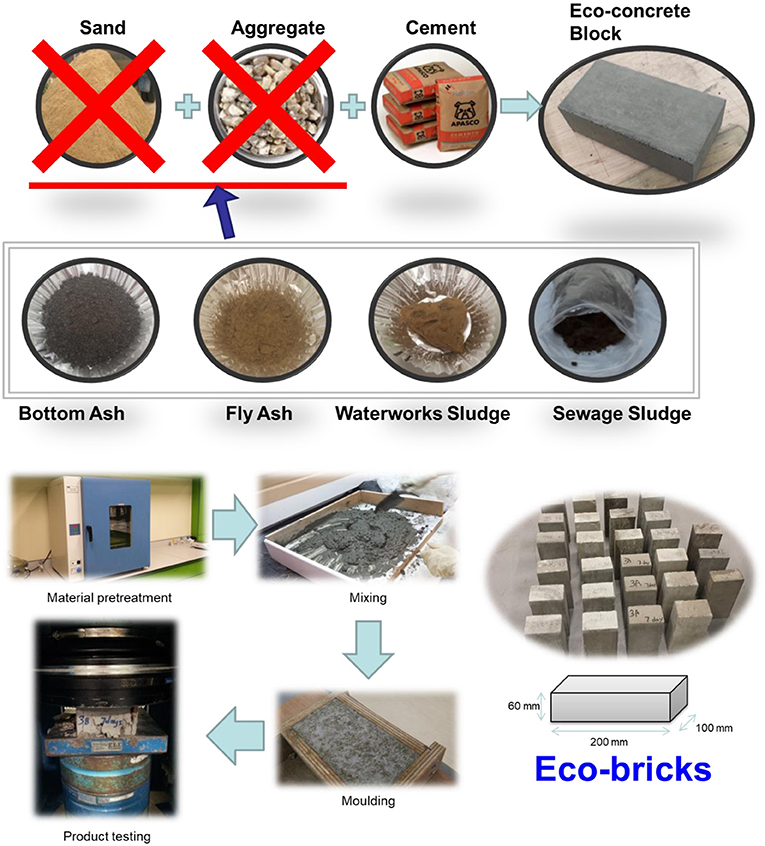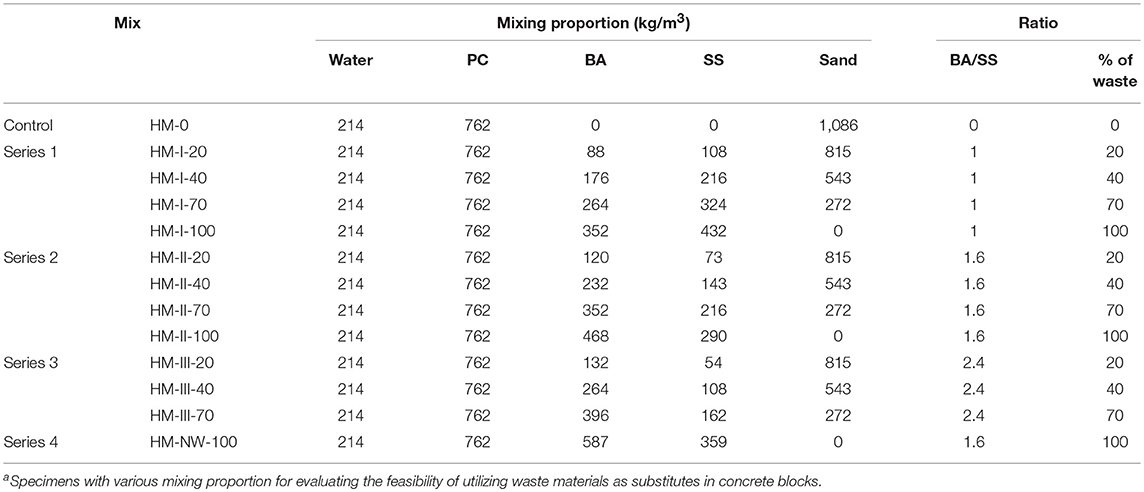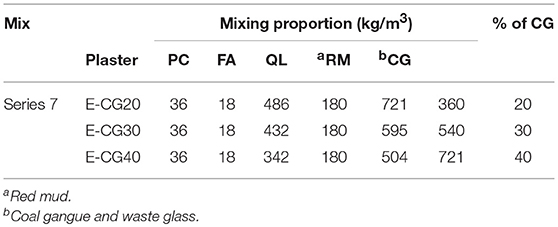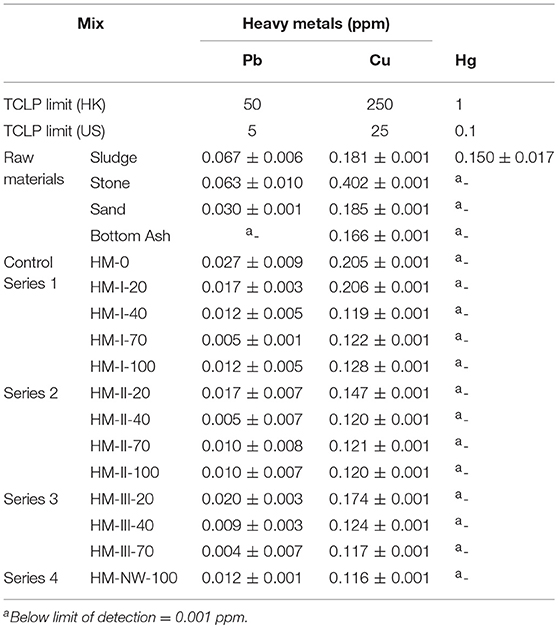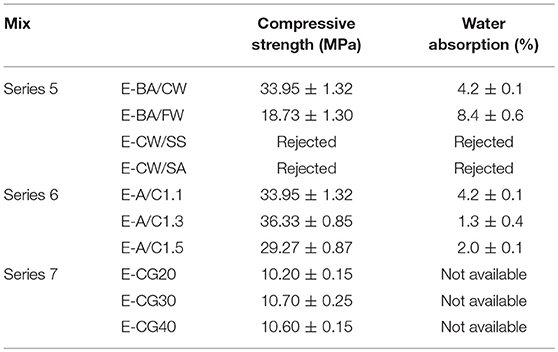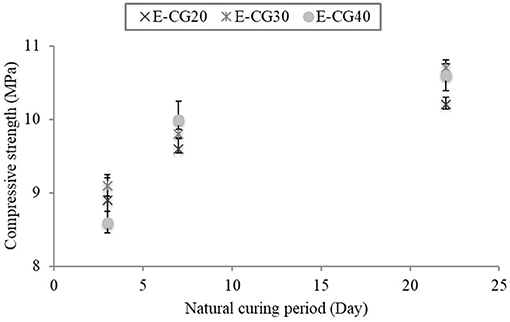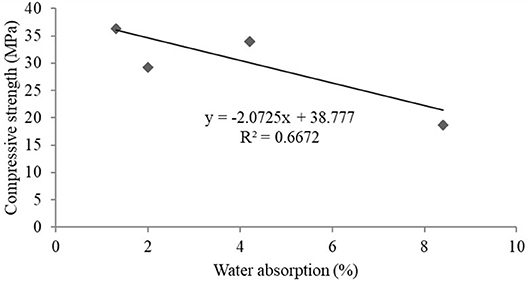- 1Department of Science and Environmental Studies, The Education University of Hong Kong, Tai Po, Hong Kong
- 2Department of Gwangyang Research Group, RIST, Gwangyang City, South Korea
- 3Environmental Science Program, Division of Science and Technology, BNU-HKBU United International College, Zhuhai, China
- 4Faculty of Science and Technology, Technological and Higher Education Institute of Hong Kong, Tsing Yi Island, Hong Kong
- 5School of Environment, Nanjing Normal University, Nanjing, China
- 6Department of Environment and Energy, Sejong University, Seoul, South Korea
This study aims to investigate the feasibility of using different waste sludge and coal combustion residuals in eco-concrete block production. The compressive strength of the eco-concrete blocks produced by waterworks sludge, bottom and fly ashes were 36 MPa, which comply with the standard specifications for paving blocks in Hong Kong. The optimal mixing proportion (by weight) of different materials in the blocks, such as aggregates, cementitious materials, water, and fly ash was 1.1:1.0:0.5:0.22, respectively. The environmental and toxicological impacts of the final products were then evaluated according to the toxicity characteristic leaching procedure (TCLP). While several heavy metals (i.e., Hg, Cu, and Pb) have been identified in the specimens, the levels of these contaminants complied with Standards (US 40 CFR 268.48). Waste materials generated from water and sewage treatment processes and power plants are feasible to be used as ingredients for paving concrete block production. These products are environmentally acceptable and mechanically suitable for resource recovery of waste materials.
Introduction
In 2015, ~15,100 tons per day (TPD) of solid waste were disposed to landfill sites in Hong Kong. However, existing landfills will be filled up by 2020 (Environmental Protection Department (EPD), 2016a; 2016b). In terms of commingling of solid waste, waste sludge is the unavoidable by-product from water and sewage treatment processes. It is classified as special waste, which cannot be easily reduced at sources (Jordan et al., 2005; Tuan et al., 2013). The amount of sludge produced could significantly increase due to future urban development, such as the North East New Territories New Development Area. The government estimates that the sludge production will increase to ~2,000 TPD by 2030 due to the completion of the Harbor Area Treatment Scheme Phase 2B (Environmental Protection Department, 2016b). The sludge treatment facility was built to alleviate the mounting pressure faced by the landfill. The facility can process 90% of the sludge volume through high-temperature incineration. However, the remaining 10% of the waste residues are still disposed to the landfill (Environmental Protection Department, 2016b). Thus, reusing and recycling of the waste sludge are win-win strategies for mitigating the load of waste treatment facilities and reducing natural resources and energy consumption.
Several studies have demonstrated the feasibility of using sewage sludge for the production of eco-construction materials, such as cement (Monzó et al., 2004; Cyr et al., 2007), lightweight aggregate (Liu et al., 2017), and ceramic tile (Jordan et al., 2005). Utilizing sewage sludge as ingredients in construction materials not only could reduce the production cost but also provide ecological and energy saving advantages (Wang et al., 2008; Liu et al., 2011; Tyagi and Lo, 2013). Despite an estimated 10,000 TPD of waterworks sludge generated globally, few studies have focused on its resource recovery (Babatunde and Zhao, 2007). In Hong Kong, ~60 TPD waterworks sludge is discarded to the landfill (Environmental Protection Department, 2016a). There is a need to find ways on how to effectively reuse waterworks sludge due to the shortage of landfill space (Tang et al., 2014; Tsang, 2015). Huang and Wang (2013) illustrated the possibility of reusing waterworks sludge in the production of lightweight aggregate. Power plant contractors also face the problem of disposing of coal combustion residuals. Considering different pozzolanic properties along with the issues of cost and environment, fly ash is mainly used in cement manufacturing, while bottom ash is utilized mainly in construction materials (Meij and Berg, 2001; Tsang, 2015). Several studies reported the feasibility of using bottom ash for different engineering purposes, such as blocks (Arenas et al., 2011) and concrete (Lee et al., 2010; Kim and Lee, 2011). Bottom ash has better performance compared with sand, in fact, the compressive strength of 100% aggregate replacement was even higher than that of reference blocks (Andrade et al., 2007). The coliform population of the sludge can also be reduced by the addition of coal fly ash (Papadimitriou et al., 2008). Supplementing with coal combustion residuals may facilitate the utilization of waste sludge as ingredients in concrete blocks. Meanwhile, Wang (2005) demonstrated the use of waste materials, such as red mud and building sand, to produce non-sintered and non-clay blocks. The resulting blocks are considered as an environmentally friendly construction material because of low cement content.
Aside from paving blocks, the Chinese Government has implemented related economic policies to encourage and regulate the production and use of new wall materials (Mohurd, 2012). These policies aim to promote the innovation of wall materials and energy-saving buildings. The Ministry of Finance and the State Administration of Taxation has made clear that enterprises using effluent, exhausted gases, waste residues, and other waste materials as primary feedstock for producing wall materials can avail of income tax reduction or exemption within 5 years. Eco-construction materials development is the trend of construction materials production. In fact, there were not many researches focus on eco-concrete block produced from mentioned waste materials. And previous researches demonstrated the feasibility of using waste materials for eco-construction materials production. These successful experiences could be applied to eco-concrete block production. Moreover, the government also supports green product production. Eco-construction materials could be developed in the future. In this study, the feasibility to reuse dewatered sludge, dried sludge, and coal combustion residues as sand and aggregate replacements for paving concrete blocks production to reduce the sludge quantities for disposal or further treatment was investigated. The ratios of different waste materials were optimized to meet the standard specifications for paving blocks. Toxicity and mechanical performance were also examined to evaluate the environmental acceptance and feasibility of the engineering view of the products.
Materials and Methods
Raw Materials
Waterworks sludge (WS), sewage sludge (SS), and sludge incineration residuals (SA) were selected to investigate the possibility of producing concrete blocks due to the properties more similar to traditional constituents. WS and SS were collected from Shaiin Sewage Treatment Works (STSTWs) and Sheung Shui Water Treatment Works (SSWTWs) in Hong Kong, respectively. SA were collected from sludge treatment facility adopted incineration at 850°C in Tune Mun, Hong Kong. WS was the aluminum-rich sludge generated in local drinking water treatment process, in which alum is used as the coagulant in coagulation-flocculation process. SS was the sludge generated from a typical secondary wastewater treatment plant. Coal combustion residuals [i.e., bottom ash (BA) and fly ash (FA)] were collected from Castle Peak Power Plant. Ordinary Portland cement (PC) equivalent to BS EN197-1:2000 sourced commercially in Hong Kong were used as cementitious materials and partially substituted by fly ash. The moisture content of waste materials was similar to typical value. Beside of waste sludge and coal combustion residuals, red mud, coal gangue, waste glass were used to produce non-sintered blocks. Red mud that is insoluble waste residual was produced during extraction and purification of aluminum oxide and consisted of fine particles and coarse granules. Coal gangue is a solid waste that generated during the process of coal mining and washing.
Experimental Design
This study was separated into two parts (Graphical Abstract). In Part one, specimens with various mixing proportion (Table 1) were produced to evaluate the feasibility of utilizing waste materials as substitutes in concrete blocks. The leachability of heavy metals (i.e., Hg, Cu, and Pb) in the eco-concrete blocks with different mixing proportions was also determined. In Part two, the mechanical performance of the specimens was evaluated according to the standard specifications for paving blocks published by Hong Kong SAR.
The water to cement (W/C) and aggregate to cement (A/C) ratios obtained during determining the effective ratio. W/C and A/C were 0.3 and 1.1, respectively. The ratios of waste material substitution to natural material varied from 20 to 100%, while the ratios of bottom ash to sewage sludge (BA/SS) varied between 1.0 and 2.4. In Series 4, moisture was provided from the SS; therefore no tap water was added to the concrete mix. Effective mixing proportion obtained from Part one would be used for the production of specimens in Part two. Different type of waste materials would substitute the natural resources in the specimens to evaluate various waste materials, which would present acceptable mechanical performance.
Coarse aggregate and fine aggregate were replaced by WS and BA, respectively. Coal combustion FA and SA would work as cementitious materials to substitute part of cement. The coarse aggregate to fine aggregate ratio was amended to 50% to 50%. The detailed information of mixing proportion of Part two is shown in Tables 2, 3. Series 5 would determine the effect of varying materials on compressive strength. In order to maximize the amount of waste materials reusing, effect of increasing A/C ratio would evaluate in series 6. Given that no standards or regulations exist to produce eco-concrete blocks in Hong Kong, and the materials used in this study were different from traditional materials in terms of physical or chemical characteristics, the W/C and A/C ratios were different from the typical ratios used. Besides, series 7 would evaluate the mechanical performance of specimens produced by waste materials. In this mix series, cement was also replaced by coal fly ash.
Materials Preparation
All waterworks sludge used in this study was oven-dried at 105°C for at least 2 days before mixing to obtain harden character to simulate the character of natural coarse aggregate. Sewage sludge cakes mixed with other materials without pretreatment to determine the effect of utilizing sludge cake to replace natural aggregate. Bottom ashes are porosities and would absorb water to reduce the free-water content for cement hydration. To maintain W/C, saturated surface-dry condition for aggregate was needed to obtain (Marsh, 1997). In this study, 18% by weight of water was added to bottom ash to reach the saturated surface-dry condition. For materials used in series 7, two-grain sizes of coal gangue and waste glass were selected, which were between 0.35 and 0.5 mm (medium size) and over 0.5 mm (coarse size). The ratio between medium-size particles and coarse-size particles was 6:4. Coal gangue and waste glass were mixed to prepare the aggregate mixture for series 7.
Effective Ratios
Waste materials properties either physically or chemically were different to natural materials utilized in the traditional concrete block. The curing performance may differ to traditional materials. More cement may be needed for concrete mix production, therefore effective ratios were needed to determine. The optimal A/C ratio for waste materials concrete mix would determine before concrete block production. Typical A/C is in the range of 3:1 to 6:1 (Shackel, 1990) and the preliminary study of A/C ratio and W/C ratio for waste materials start with 4:1 and 0.6, respectively. For W/C ratio, it is not the critical factor at this part; the typical value was applied here. Preliminary study for effective ratio would proceed until specimens' cure successfully on Day 1.
Specimens Preparation
Hundred wooden molds fabricated according to Civil Engineering and Development Department (CEDD) standard for the concrete paving block (i.e., L × W × H: 200 × 100 × 60 mm) were used in parts one and two studies (CEDD, 2006). The concrete mixtures were prepared by the hand-mixing method and vibrate manually to eliminate the air trapped in the mixture. The specimens were removed from the molds and cure in water for 28 days on day 1. In series 7, the sizes of specimens were in the shape of a cylinder with 40 mm (diameter) and 13.2 mm (height).
Analytical Methods
Leachability of heavy metals was determined by Toxicity Characteristic Leaching Procedures (TCLP, USEPA Method 1311, 1992), which is common practice to evaluate leachability of waste and contaminated soils. According to USEPA and Hong Kong TCLP limits, the selected analytes included Cd, Cr, Cu, Pb, Hg, Ni, Zn, and As (Environmental Protection Department, 2011). Samples were leached with 0.5 M glacial acetic acid at liquid to solid ratio of 20 L/kg and rotated for 18 h at 30 rpm. The sample solutions after extraction were analyzed by inductively coupled plasma-atomic emission spectrometry (ICP-AES) (Perkin Elmer Optima 3300DV, USA) and inductively coupled plasma-mass spectrometry (ICP-MS) (Agilent 7900, USA). In addition, 2 mg/L standard solution was analyzed every 10 samples and after the whole sequence of determination for QA/QC. All samples were determined in triplicate (Li et al., 2017)
For other analytical methods on mechanical performance, compressive strength test was complied with local civil engineering works standard. Water absorption test was condcuted according to AS/NZS 4456.14 (n = 3). Compressive strength test was determined by automatic compression machines (36-5165/01, ELE International, UK) with compression speed 6,800 N per second and “non-standard” for size setting (n = 3). The compressive strength was calculated by determining the breaking load of the specimens. The compressive strength of specimens in series 7 would be evaluated according to GB5101-2003, which is a collection of current common sintered brick's national standards in the People's Republic of China.
Results and Discussion
Effective Ratios
W/C ratio and A/C ratio for waste materials utilized in the concrete mix were determined. The A/C ratio for waste materials was dramatically lower than typical A/C ratio, and a relatively high amount of cementitious materials was needed. A/C ratio for waste materials was 1.1, which can cure successfully on Day 1. The high amount of cementitious materials was needed may due to bottom ash, which is porous materials and representing of large surface area compare to natural aggregate (Singh and Siddique, 2013). In this study, The A/C ratio and W/C ratio of effective mixing proportion is 1.1 and 0.5. And the A/C ratio in this study was higher than Poon and Lam (2008) mentioned. The author recommended A/C ratio with 3 is suitable for eco-friendly concrete block production. Regarding W/C ratio, it is like the typical value, 0.6 (Jiménez et al., 2014). It may vary due to the difference of a characteristic of materials.
Leachability of Heavy Metals
In Part one study, leachability of heavy metals in specimens was determined through TCLP to evaluate the environmental impacts of specimens produced by waste materials, including different types of sludge and ashes. The results of the TCLP are summarized in Table 4. The concentrations of Cd, Cr, Ni, As, and Zn were below the limit of detection (LoD). However, Pb, Cu, and Hg were detected from both specimens and raw materials. Compared with the specimens, the relatively high concentrations of heavy metals were detected from raw materials. However, the concentrations of metal leached from the specimens were lower than those from raw materials samples. It may be due to the immobilization of heavy metals during cement hydration reaction.
Solidification/stabilization (S/S) is the commonly used technique in the world to reduce the toxicity of the waste materials for treatment of contaminated soil and sludge (Li et al., 2001; Valls and Vàzquez, 2002; Malviya and Chaudhary, 2006; Chen et al., 2009; ÖzverdI and Erdem, 2010). Solidification converts waste material from liquid phase to solid phase and strength development (Hills and Pollard, 1997; Chen et al., 2009). Due to this technique not only solidification but also reduce the toxicity and leachability through insolubilize and immobilize the waste materials, it become non-hazardous or less hazardous to achieve waste materials stabilization (Hills and Pollard, 1997; Malviya and Chaudhary, 2006). Cement-based S/S processes are suitable for treating heavy metal-contaminated sludge or soils because hazardous components are difficult to leach from concrete materials (Marion et al., 2005; Malliou et al., 2007; Qiao et al., 2007). Moreover, some studies demonstrated the possibility of using cement to treat heavy metals. Hills and Pollard (1997) found that the concentration of zinc in the specimen has reduced about 99% on Day 28. In addition, Antemir et al. (2010) have conducted a series test about the long-term performance of S/S and the test up to 16 years. The results indicated that the contaminants leach from the S/S soil was not excess the specific limit and the contaminant was immobilized in the solid for a long period of time. On the other hands, Marion et al. (2005) have studied the leaching behavior of paving concrete mixing with slag and reported there is no systematic correlation between the heavy metal content and the leached heavy metal from concrete. And authors comment that there is no significant risk of contamination of soil and water. Based on these previous studies, cement-based S/S processes are available to treat heavy metal.
Compressive Strength Test
The compressive strength test was conducted on Day 28 in Part two study. Compressive strength was calculated according to local civil engineering standard for concrete paving blocks (Table 5). In this part, different types of materials were utilized to replace coarse and fine aggregate. The results were indicated that the series, which were consisting of sewage sludge cake and sludge incineration residuals was failed to cure on Day 1. The texture of specimens consist of sewage sludge cake was sponge-like and soft. The strength of the cement matrix, aggregate and interfacial bond between the cement matrix and aggregate are the factors affecting the strength of concrete (Poon et al., 2004). Fail to may be attributed to the type of aggregate and interfacial bond between the cement matrix and aggregate. Whereas, the texture of specimens consists of sludge incineration residuals was cracked on Day 1. Thermal expansion may become the reason for cracking. When deformation of concrete is restrained, thermal stress will occur. Thermal stress is greater than tensile strength consequently cracking of the concrete (McCarthy et al., 2015; Siddiqui and Fowler, 2015). Another researcher also points out thermal stress is affecting durability and the life of concrete due to thermal stress generated by cement hydration greater than loading of concrete (Siddiqui and Fowler, 2015). Therefore, series mixed with sewage sludge and sludge incineration residuals were rejected and no further analysis to evaluate the mechanical performance. Dewatered sewage sludge and sludge incineration residuals may not be suitable for substitute into the concrete mix without pretreatment and admixture addition to improving the early strength of the specimens. Weak initial strength results in thermal expansion cracking due to generated by cement hydration (Hoang et al., 2016).
In series 5, only concrete mix E-BA/CW, which was consisting of bottom ash and coarse waterworks sludge, reached the local concrete paving block standard, 30 MPa (Table 5). On the other hands, the compressive strength of concrete mix E-BA/FW was 18.7 MPa. It may because the coarse aggregate was replaced by fine waterworks sludge. The appearance like mortar but not concrete, which is similar to the results obtained by Wang et al. (2015). Coarse aggregate presented a significant effect on compressive strength. Compressive strength was increased with increasing amount of coarse aggregate. In order to optimize the amount of reusing waste materials, the correlation between different A/C ratios and compressive strength was also determined in series 6. E-A/C1.1 and E-A/C1.3 represent the satisfied compressive strength, which was 33.9 ± 1.3 and 36.3 ± 0.85, respectively (Table 5). When A/C ratio increased to 1.5, the compressive strength was begun to decrease. It may due to increasing of bottom ash and need more cementitious materials for concrete production. However, the previous study indicated that the compressive strength of concrete mixture, which was replace fine aggregate by coal bottom ash was greater than concrete mix consists of sand. Because of the pozzolanic effect of coal bottom ash begun affecting the chemical reaction inside the concrete and enhancing the properties of concrete after the curing period (Singh and Siddique, 2014). It would be possible to utilizing waster sludge and coal combustion residuals to produce eco-concrete blocks with A/C ratio 1.5.
Regarding the preliminary study of non-sintered and non-clay standard size block, the compressive strength of all concrete mixes was reached MU10 mentioned in GB5101-2003. The results for these concrete mixes are summarized in Table 5. From Figure 1, the trend of the difference of compressive strength for concrete mix E-CG20 and E-CG40 become stability on Day 28 and tendencies for increasing of compressive strength of E-CG30 was slightly greater than E-CG40 and E-CG20. Therefore, the compressive strength of E-CG30 would keep rising in the following days. E-CG30's tendency for increasing of compressive strength is greater than E-CG20 and E-CG40, which means that according to the average natural curing period (28 days), the compressive strength of E-CG30's blocks, would increase more significantly than the others, and the final compressive strength may be higher.
Water Absorption Test
Water absorption test was conducted, and the procedure was complying with local civil engineering standard. The results of water absorption test are summarized in Table 5. Excepting concrete mix E-BA/FW, every concrete mix was below 6% and not exceeds the standard limit. Specimens in concrete mix E-BA/CW not only have the highest strength but also have the lowest water absorption value. Compare to another study, the result of water absorption test was lower with similar coal bottom ash substitution. Singh and Siddique (2015) obtained the water absorption was fall in the range from 4.7 to 5.6% on Day 28. In addition, the author also found that the voids of bottom ash were filled Ettringites needle and a high amount of calcium silicate hydrate (CSH) gel in the bottom ash concrete on Day 90. Concrete mix E-BA/FW may reach the satisfied water absorption value on Day 90.
Correlation of Compressive Strength and Water Absorption
In this study, the strong correlation of compressive strength and water absorption test was found. From the Figure 2, when decreasing of compressive strength of concrete mix E-BA/FW and E-A/C1.5, the water absorption value of these concrete mixes were increased simultaneously. When conducted water absorption test, a lot of air bubbles occurred during the early stage of this test. It reflects that there were some spaces presences inside the concrete block. A similar result was obtained from another study, Singh and Siddique (2014) found that the compressive strength of bottom ash concrete was lower than river sand concrete at early curing age. Authors summarized the increased porosity of concrete was one of the reasons for that. Whereas, authors also found that the pozzolanic effect of coal bottom ash was begun to react with calcium hydroxide and form C-S-H gel and this gel was filled up the void of bottom ash on Day 14. Coal bottom ash could enhance the compressive strength of bottom ash concrete after the curing age and bottom ash reach the almost similar properties to river sand with more extended curing age were summarized by Singh and Siddique.
Conclusions
In this study, different kinds of waste materials, which are the unavoidable by-products from wastewater treatment and power generation processes, were utilized to produce eco-concrete blocks. The results indicated that eco-concrete blocks consisting of waterworks sludge (in coarse size) and coal bottom ash were feasible for use in eco-concrete blocks production. The specimens reached the requirements stated in the General Specifications from the Hong Kong Government and did not exceed the toxicity characteristic leaching procedure standards. The mixing proportion of eco-concrete block production was dramatically different compared with concrete produced from raw materials. The A/C and W/C ratios were 1.1 and 0.5, respectively. Aside from eco-concrete paving blocks, non-sintered and non-clay blocks production from wastes (i.e., sludge and incinerated residues) was evaluated from an engineering viewpoint. The results showed that non-sintered and non-clay blocks produced with large fractions in waste materials reached MU10 in GB5101-2003. The proposed method will provide potentially inexpensive sources of environmentally friendly construction materials with desirable properties through the exploration of novel and advanced routes for resource recovery. It not only converts such wastes into useful materials but also helps alleviate the shortage of landfill sites. Hence, the practice of reusing waste materials is a win-win strategy that can alleviate raw material consumption during urban development in China. It not only reduces the quantity of sludge and incinerated residues for further treatment, but also provides a cost-effective and energy-efficient method for eco-construction materials production.
Author Contributions
WC: analysis and interpretation of the data/Drafting of the article/Critical revision of the article for important intellectual content/Collection and assembly of data/Administrative, technical, or logistic support/Final approval; HY: analysis and interpretation of the data/Drafting of the article/Critical revision of the article for important intellectual content/Collection and assembly of data/Final approval; CY: conception and design/Analysis and interpretation of the data/Critical revision of the article for important intellectual content/Administrative, technical, or logistic support/Final approval; HW: analysis and interpretation of the data/Critical revision of the article for important intellectual content/Collection and assembly of data/Administrative, technical, or logistic support/Final approval; GW: critical revision of the article for important intellectual content/Obtaining of funding/Final approval; EK: drafting of the article/Critical revision of the article for important intellectual content/Administrative, technical, or logistic support/Final approval; YT: conception and design/Analysis and interpretation of the data/Drafting of the article/Critical revision of the article for important intellectual content/Collection and assembly of data/Obtaining of funding/Administrative, technical, or logistic support/Final approval of the article.
Conflict of Interest Statement
The authors declare that the research was conducted in the absence of any commercial or financial relationships that could be construed as a potential conflict of interest.
Acknowledgments
This work was financially supported by the Research Grants Council of the Hong Kong SAR, China (No.: 18202116), the Research Cluster Fund (RG50/2017-2018R), the Dean's Research Fund (No.: DRF/SFRS-8 and DSRAF-6 SP1), and the Internal Research Grant (No.: RG 78/2015-2016R and RG 34/2017-2018R) of The Education University of Hong Kong.
Abbreviations
A/C, aggregate to cement; BA, bottom ash; CEDD, Civil Engineering and Development Department; EPD, Environmental Protection Department; FA, fly ash; ICP-AES, inductively coupled plasma-atomic emission spectrometry; ICP-MS, inductively coupled plasma-mass spectrometry; LoD, limit of detection; PC, Portland cement; S/S, solidification/stabilization; SA, sludge incineration residuals; SS, sewage sludge; SSWTWs, Sheung Shui Water Treatment Works; STSTWs, Shatin Sewage Treatment Works; TCLP, toxicity characteristic leaching procedure; TPD, tons per day; W/C, water to cement; WS, waterworks sludge.
References
Andrade, L. B., Rocha, J. C., and Cheriaf, M. (2007). Evaluation of concrete incorporating bottom ash as a natural aggregates replacement. Waste Manage. 27, 1190–1199. doi: 10.1016/j.wasman.2006.07.020
Antemir, A., Hills, C. D., Carey, P. J., Gardner, K. H., Bates, E. R., and Crumbie, A. K. (2010). Long-term performance of aged waste forms treated by stabilization/solidification. J. Hazard. Mater. 181, 65–73. doi: 10.1016/j.jhazmat.2010.04.082
Arenas, C. G., Marrero, M., Leiva, C., Solís- Guzmán, J., and Arenas, L. V. (2011). High fire resistance in blocks containing coal combustion fly ashes and bottom ash. Waste Manage. 31, 1783–1789. doi: 10.1016/j.wasman.2011.03.017
Babatunde, A. O., and Zhao, Y. Q. (2007). Constructive approaches towards water treatment works sludge management: an international review of beneficial re-uses. Crit. Rev. Env. Sci. Tech. 37, 129–164. doi: 10.1080/10643380600776239
CEDD (2006). General Specification for Civil Engineering Works. Civil Engineering and Development Department, HKSAR. Available online at: http://www.cedd.gov.hk/eng/publications/standards_handbooks_cost/doc/stan_gs_2006/GS%202006%20Vol%202%20Rev%2016-161230.pdf
Chen, Q. Y., Tyrer, M., Hills, C. D., Yang, X. M., and Carey, P. (2009). Immobilisation of heavy metal in cement-based solidification/stabilisation: a review. Waste Manage. 29, 390–403. doi: 10.1016/j.wasman.2008.01.019
Cyr, M., Coutand, M., and Clastres, P. (2007). Technological and environmental behavior of sewage sludge ash (SSA) in cement-based materials. Cement Concrete Res. 37, 1278–1289. doi: 10.1016/j.cemconres.2007.04.003
Environmental Protection Department (2011). Practice Guide for Investigation and Remediation of Contaminated Land. Environmental Protection Department, HKSAR. Available online at: http://www.epd.gov.hk/epd/sites/default/files/epd/gn_pdf/GN2014P244-2011c-e.pdf
Environmental Protection Department (2016a). Monitoring of Solid Waste in Hong Kong 2015. Environmental Protection Department, HKSAR. Available online at: https://www.wastereduction.gov.hk/sites/default/files/msw2015.pdf
Environmental Protection Department (2016b). Sludge Treatment Facility (STF). Waste – Problem and Solutions. Environmental Protection Department, HKSAR. Available online at: http://www.epd.gov.hk/epd/english/environmentinhk/waste/prob_solutions/Sewage_Sludge.html
Hills, C. D., and Pollard, S. J. T. (1997). The influence of interference effects on the mechanical, microstructural and fixation characteristics of cement-solidified hazardous waste forms. J. Hazard. Mater. 52, 171–191. doi: 10.1016/S0304-3894(96)01806-7
Hoang, K., Justnes, H., and Geiker, M. (2016). Early age strength increase of fly ash blended cement by a ternary hardening accelerating admixture. Cement Concrete Res. 81, 59–69. doi: 10.1016/j.cemconres.2015.11.004
Huang, C. H., and Wang, S. Y. (2013). Application of water treatment sludge in the manufacturing of lightweight aggregate. Constr. Build. Mater. 43, 174–183. doi: 10.1016/j.conbuildmat.2013.02.016
Jiménez, C., Barra, M., Valls, S., Aponte, D., and Vázquez, E. (2014). Durability of recycled aggregate concrete designed with the equivalent mortar volume (EMV) method: validation under the Spanish context and its adaptation to bolomey methodology. Mater. Construct. 64:313. doi: 10.3989/mc.2013.00913
Jordan, M. M., Almendro-Candel, M. M., Romero, M., and Rincon, J. M. (2005). Application of sewage sludge in the manufacturing of ceramic tile bodies. Appl. Clay Sci. 30, 219–224. doi: 10.1016/j.clay.2005.05.001
Kim, H. K., and Lee, H. K. (2011). Use of power plant bottom ash as fine and coarse aggregates in high-strength concrete. Constr. Build. Mater. 25, 1115–1122. doi: 10.1016/j.conbuildmat.2010.06.065
Lee, H. K., Kim, H. K., and Hwang, E. A. (2010). Utilization of power plant bottom ash as aggregates in fiber-reinforced cellular concrete. Waste Manage. 30, 274–284. doi: 10.1016/j.wasman.2009.09.043
Li, J. S., Beiyuan, J., Tsang, D. C., Wang, L., Poon, C. S., Li, X. D., et al. (2017). Arsenic-containing soil from geogenic source in Hong Kong: leaching characteristics and stabilization/solidification. Chemosphere 182, 31–39. doi: 10.1016/j.chemosphere.2017.05.019
Li, X. D., Poon, C. S., Sun, H., Lo, I. M. C., and Kirk, D. W. (2001). Heavy metal speciation and leaching behaviors in cement based solidified/stabilized waste materials. J. Hazard. Mater. 82, 215–230. doi: 10.1016/S0304-3894(00)00360-5
Liu, M., Xu, G., and Li, G. (2017). Effect of the ratio of components on the characteristics of lightweight aggregate made from sewage sludge and river sediment. Process Saf. Environ. Prot. 105, 109–116. doi: 10.1016/j.psep.2016.10.018
Liu, Z. H., Chen, Q. Y., Xie, X. B., Xue, G., Du, F. F., Ning, Q. Y., et al. (2011). Utilization of the sludge derived from dyestuff-making wastewater coagulation for unfired bricks. Constr. Build. Mater. 25, 1699–1706. doi: 10.1016/j.conbuildmat.2010.10.012
Malliou, O., Katsioti, M., Georgiadis, A., and Katsiri, A. (2007). Properties of stabilized/solidified admixtures of cement and sewage sludge. Cement Concrete Comp. 29, 55–61. doi: 10.1016/j.cemconcomp.2006.08.005
Malviya, R., and Chaudhary, R. (2006). Factors affecting hazardous waste solidification/stabilization: a review. J. Hazard. Mater. 137, 267–276. doi: 10.1016/j.jhazmat.2006.01.065
Marion, A. M., De Lanève, M., and De Grauw, A. (2005). Study of the leaching behaviour of paving concretes: quantification of heavy metal content in leachates issued from tank test using demineralized water. Cement Concrete Res. 35, 951–957. doi: 10.1016/j.cemconres.2004.06.014
Marsh, B. K. (1997). Design of Normal Concrete Mixes, 2nd Edn. England: Building Research Establishment Ltd
McCarthy, L. M., Gudimettla, J. M., Crawford, G. L., Guercio, M. C., and Allen, D. (2015). Impacts of variability in coefficient of thermal expansion on predicted concrete pavement performance. Constr. Build. Mater. 93, 711–719. doi: 10.1016/j.conbuildmat.2015.04.058
Meij, R., and Berg, J. (2001). “Coal fly ash management in Europe trends, regulations and health and safety aspects,” in International Ash Utilization Symposium. Available online at: http://www.flyash.info/2001/keynote/108meij.pdf
Mohurd. (2012). Special Guideline for Building Energy Conservation during Twelfth Five-Year Plan Period. Retrieved from: http://www.gov.cn/zwgk/2012-05/31/content_2149889.htm
Monzó, J., Paya, J., Borrachero, M. V., and Girbes, I. (2004). Reuse of sewage sludge ashes (SSA) in cement mixtures: the effect of SSA on the workability of cement mortars. Waste Manage. 23, 373–381. doi: 10.1016/S0956-053X(03)00034-5
ÖzverdI, A., and Erdem, M. (2010). Environmental risk assessment and stabilization/solidification of zinc extraction residue: I. Environmental risk assessment. Hydrometallurgy 100, 103–109. doi: 10.1016/j.hydromet.2009.10.011
Papadimitriou, C. A., Haritou, I., Samaras, P., and Zouboulis, A. I. (2008). Evaluation of leaching and ecotoxicological properties of sewage sludge–fly ash mixtures. Env. Res. 106, 340–348. doi: 10.1016/j.envres.2007.04.007
Poon, C. S., and Lam, C. S. (2008). The effect of aggregate to cement ratio and types of aggregate on the properties of pre-cast concrete blocks. Cement Concrete Comp. 30, 283–289. doi: 10.1016/j.cemconcomp.2007.10.005
Poon, C. S., Shui, Z. H., Lam, L., Fok, H., and Kou, S. C. (2004). Influence of moisture states of natural and recycled aggregates on the slump and compressive strength of concrete. Cement Concrete Res. 34, 31–36. doi: 10.1016/S0008-8846(03)00186-8
Qiao, X. C., Poon, C. S., and Cheeseman, C. R. (2007). Investigation into the stabilization/solidification performance of Portland cement through cement clinker phases. J Hazard. Mater. 139, 238–243. doi: 10.1016/j.jhazmat.2006.06.009
Shackel, B. (1990). Design and Construction of Interlocking Concrete Block Pavements. London: Elsevier Applied Science
Siddiqui, M. S., and Fowler, D. W. (2015). A systematic optimization technique for the coefficient of thermal expansion of Portland cement concrete. Constr. Build. Mater. 88, 204–211. doi: 10.1016/j.conbuildmat.2015.04.008
Singh, M., and Siddique, R. (2013). Effect of coal bottom ash as partial replacement of sand on properties of concrete. Resour. Conserv. Recy. 72, 20–32. doi: 10.1016/j.resconrec.2012.12.006
Singh, M., and Siddique, R. (2014). Strength properties and micro-structural properties of concrete containing coal bottom ash partial replacement of fine aggregate. Constr. Build. Mater. 50, 246–256. doi: 10.1016/j.conbuildmat.2013.09.026
Singh, M., and Siddique, R. (2015). Properties of concrete containing high volumes of coal bottom ash as fly aggregate. J. Clean. Prod. 91, 269–278. doi: 10.1016/j.jclepro.2014.12.026
Tang, Y. Y., Chan, S. W., and Shih, K. M. (2014). Copper stabilization in beneficial use of waterworks sludge and copper-laden electroplating sludge for ceramic materials. Waste Manage. 34, 1085–1091. doi: 10.1016/j.wasman.2013.07.001
Tsang, Y. F. (2015). “Environmental protection and pollution management in China,” in The Entrepreneurial Rise in Southeast Asia–The Quadruple Helix Influence on Technological Innovation, eds S. Sindakis and C. Walter (New York, NY: Palgrave Macmillan), 309–336
Tuan, B. L. A., Hwang, C. L., Lin, K. L., Chen, Y. Y., and Young, M. P. (2013). Development of lightweight aggregate from sewage sludge and waste glass powder for concrete. Constr. Build. Mater. 47, 334–339. doi: 10.1016/j.conbuildmat.2013.05.039
Tyagi, V. K., and Lo, S. L. (2013). Sludge: a waste or renewable source for energy and resources recovery? Renew. Sust. Energ. Rev. 25, 708–728. doi: 10.1016/j.rser.2013.05.029
Valls, S., and Vàzquez, E. (2002). Leaching properties of stabilised/solidified cement-admixtures-sewage sludges systems. Waste Manage. 22, 37–45. doi: 10.1016/S0956-053X(01)00027-7
Wang, H. L., Brown, S. L., Magesan, G. N., Slade, A. H., Quintern, M., Clintion, P. W., et al. (2008). Technological options for the management of biosolids. Env. Sci. Poll. Res. 15, 308–317. doi: 10.1007/s11356-008-0012-5
Keywords: resource recovery, construction materials, sewage sludge, waterworks sludge, solidification
Citation: Cheng WN, Yi H, Yu C-f, Wong HF, Wang G, Kwon EE and Tsang YF (2019) Biorefining Waste Sludge From Water and Sewage Treatment Plants Into Eco-Construction Material. Front. Energy Res. 7:22. doi: 10.3389/fenrg.2019.00022
Received: 31 October 2018; Accepted: 14 February 2019;
Published: 19 March 2019.
Edited by:
Mohammad Rehan, King Abdulaziz University, Saudi ArabiaReviewed by:
Sidney Man Ngai Chan, Open University of Hong Kong, ChinaNa Duan, China Agricultural University, China
Copyright © 2019 Cheng, Yi, Yu, Wong, Wang, Kwon and Tsang. This is an open-access article distributed under the terms of the Creative Commons Attribution License (CC BY). The use, distribution or reproduction in other forums is permitted, provided the original author(s) and the copyright owner(s) are credited and that the original publication in this journal is cited, in accordance with accepted academic practice. No use, distribution or reproduction is permitted which does not comply with these terms.
*Correspondence: Yiu Fai Tsang, dHNhbmd5ZkBlZHVoay5oaw==
†These authors have contributed equally to this work and are co-first authors
 Wai Nam Cheng
Wai Nam Cheng Haakrho Yi2†
Haakrho Yi2† Chun-fai Yu
Chun-fai Yu Yiu Fai Tsang
Yiu Fai Tsang